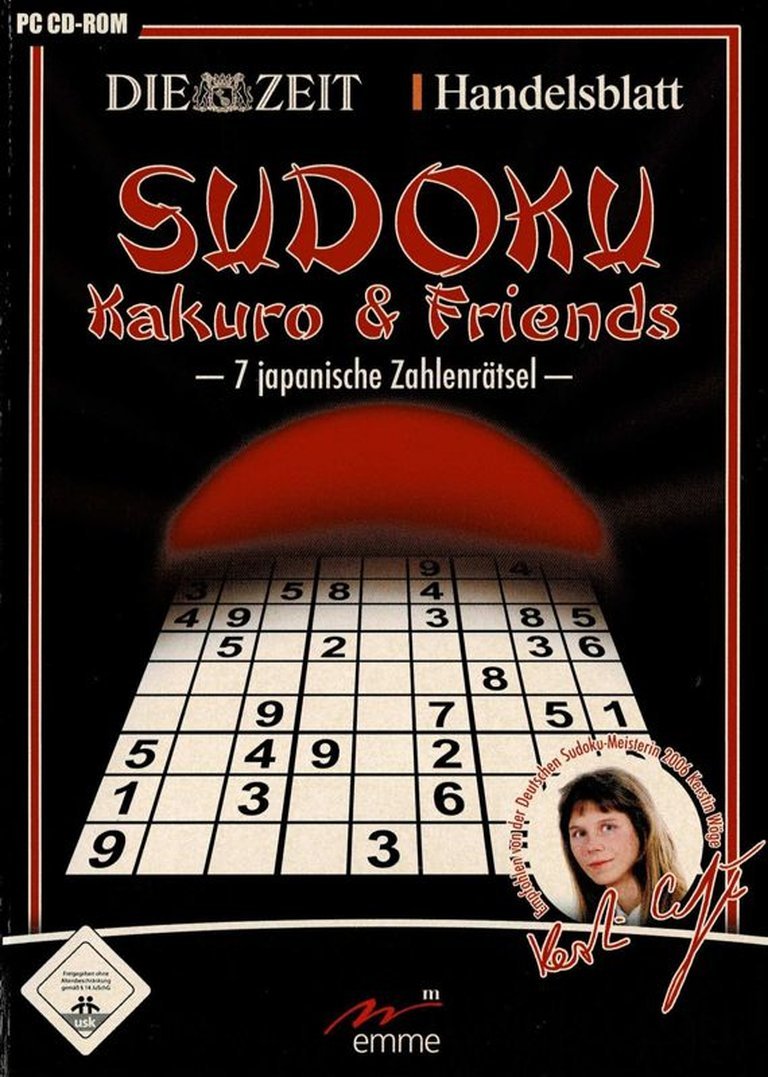- Release Year: 2006
- Platforms: Windows
- Publisher: cerasus.media GmbH
- Developer: cerasus.media GmbH
- Genre: Kakuro, Number puzzle, Puzzle, Sudoku, Word
- Perspective: Top-down
- Game Mode: Single-player
- Gameplay: Grid-based puzzles, Logic puzzles, Number placement

Description
Sudoku, Kakuro & Friends is a puzzle game collection featuring seven classic logic games, including Sudoku, Kakuro, Slither Link, Hitori, Kuromasu, Nurikabe, and Sikaku. Players solve number-based challenges by filling grids, drawing lines, or coloring squares according to specific rules, with varying difficulty levels and mouse-controlled gameplay.
Sudoku, Kakuro & Friends Free Download
Sudoku, Kakuro & Friends Reviews & Reception
metacritic.com : Awful interface, awful presentation, and just a terrible waste of twenty dollars. You almost want to spend the money just to see how not to do a Sudoku game.
Sudoku, Kakuro & Friends: Review
Introduction
Sudoku, Kakuro & Friends is a downloadable puzzle game that brings together seven classic logic games from paper and pencil into a digital format. Released in 2006 by cerasus.media GmbH, this Windows exclusive aims to provide a comprehensive collection of popular Japanese number puzzles. But does this collection live up to the hype of the Sudoku boom era, or does it get lost in a maze of numbers?
Development History & Context
The mid-2000s saw a Sudoku craze sweep the globe, prompting publishers to release numerous puzzle games. Sudoku, Kakuro & Friends entered this market by bundling multiple puzzle types. The development team at cerasus.media GmbH likely capitalized on the growing interest in these logic challenges, anticipating a niche market for puzzle enthusiasts. Technological constraints of the time meant PC games had to be efficient, so the game was built for Windows with basic graphical requirements.
Narrative & Thematic Deep Dive
Unlike narrative-driven games, Sudoku, Kakuro & Friends focuses entirely on gameplay. Each puzzle type is presented in its own interface with minimal story context. The core theme is logic and deduction, as players tackle numerical challenges. The absence of a narrative allows the game to appeal to a wide audience seeking mental stimulation without the need for reading comprehension, especially important in a global market.
Gameplay Mechanics & Systems
The game features seven distinct puzzle modes, each with unique mechanics:
-
Sudoku: 9×9 grid divided into 3×3 regions. Numbers 1-9 must be filled once per row, column, and region. The game offers varying difficulty levels and a print function for traditional solving.
-
Kakuro: Crossword-style puzzle where numbers sum to clues, using digits 1-9 without repetition. The interface provides sum hints and valid number suggestions.
-
Slither Link (Suriza): Create a loop around numbered squares indicating sides to use. The game tracks connection lines and ensures no overlaps.
-
Hitori: Variant of Sudoku where all numbers are pre-filled, and players mark incorrect numbers to meet the Sudoku constraints. The game uses color coding for correct/incorrect cells.
-
Kuromasu: Color cells black based on numeric clues indicating visible squares. Ensures all white cells form a connected area without adjacent black cells.
-
Nurikabe: Similar to Kuromasu but connects black cells. Clues indicate connected regions surrounded by white cells.
-
Sikaku: Divide grid into rectangles based on numeric clues indicating total covered squares. Must fill grid without overlaps.
Each puzzle has difficulty settings, help functions, and undo options. The interface is mouse-driven, with pop-up number selectors. While inputs are basic, some might find the click-based approach tedious compared to keyboard shortcuts.
However, the lack of a consistent UI between puzzle types can be jarring. For example, Sudoku’s interface may differ from Kakuro’s, leading to a fragmented experience rather than a cohesive collection. Additionally, some puzzles might have clunky interfaces, like Slither Link’s line drawing, which might not capture the fluidity of pen-and-paper solving.
World-Building, Art & Sound
The game’s art style is minimalistic and functional, with each puzzle presented in a clean, grid-based layout. Visual elements vary by puzzle, such as Sudoku’s classic 9×9 grid with 3×3 regions highlighted, while Hitori uses a checkerboard-like setup. The simplicity caters to puzzle purists who prefer no visual distractions.
Background music is soft and ambient, helping create a relaxing environment. Sound effects are subtle, like clicks when placing numbers or errors signaling incorrect moves. The overall atmosphere is calm and focused, ideal for puzzle solving.
Reception & Legacy
Critical reception for Sudoku, Kakuro & Friends is mixed. While the variety of puzzles is appreciated, the game’s interfaces received scrutiny. IGN’s review for the similar DS title Sudokuro called it “an awful interface, awful presentation, and just a terrible waste of twenty dollars.” Similarly, some users might find the PC version lacks polish in UI design and input responsiveness.
Commercially, the game might have had limited success due to competition from other Sudoku and puzzle collections. Its legacy is that of a decent effort in adapting classic puzzles to digital but not revolutionizing the genre. Later games like Brain Age for DS would capitalize on similar puzzle concepts with better UI and portability.
Conclusion
Sudoku, Kakuro & Friends is a functional but unremarkable collection of classic logic games. It’s commendable for including multiple puzzle types but falls short in execution with inconsistent interfaces and lack of innovative features. For dedicated fans of these puzzles, it’s a viable option, but those seeking exceptional game design may find better alternatives. The game holds a place in the Sudoku boom era but doesn’t stand out as a landmark title.